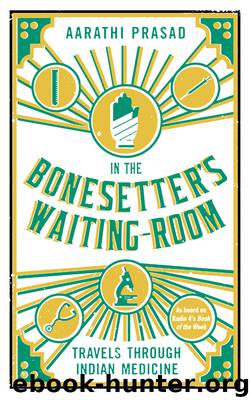In the Bonesetter's Waiting Room by Aarathi Prasad

Author:Aarathi Prasad
Language: eng
Format: epub
Publisher: Profile Books
5
Blood, Bile, Bone
I COULDN’T HELP WATCHING the reflection of his face in the rear-view mirror as Hakim Sultan Rasool carefully pulled a barbed thorn from his lip. It bled a little as it caught the skin and he flinched.
A few minutes earlier, he had asked our driver to make a sudden stop – one of many we would make on our early morning forage out towards the more rural landscapes outside Hyderabad, along roads that connected the old city with the new airport. This time, we had pulled up outside a one-roomed house, its once vibrant blues bleached over the years by the burning sun and and pristine whites stained by the monsoon rains. The front door was shrouded in a tattered curtain and, where there might have been a path to it, what looked like a grave covered in fleshy shards of aloe vera blocked the way. To one side was a low-growing cactus, its flat leaves bordered by spikes and flanked by an infantry of razor-sharp bristles. Hakim Sultan Rasool picked up a twig, wrapped it round one of the plant’s prickly pear fruits and twisted hard. A sliver of a woman’s face appeared, peering through the curtain. She made no objection to us being on her land and instead watched as he broke the fruit open and offered me a look at its oozing crimson flesh. ‘The fruit is used to make a syrup,’ he explained, ‘for chronic tuberculosis. And I use Aloe in a formulation that works till second grade carcinoma.’ He pointed to the ‘grave’. ‘After that it doesn’t work though. But people don’t know this medicinal value. It’s growing right in front of them, but they don’t know.’ He paused to swallow the pulp of one half of the cactus fruit and as he felt its sharp prick tossed the other back under the plant.
As we travelled on, the hakim, my Urdu translator Ramal Alwi and I passed littered undeveloped plots in small roadside towns, sparsely scattered mosques and homes and more wooded areas. As we went, Rasool pointed out the trees, shrubs, flowers, berries and barks he experimented with in his medical formulations. There were flowers used to treat rabies, the milky sap of leaves for the purification of blood, plants for jaundice, enlarged lymph nodes, palpitations, bronchitis, ulcers and first-stage uterine carcinoma. Occasionally, he ate a flower or leaf, ‘Only because I know how to eat them,’ he told me. ‘Hm. This one is very bitter,’ he said, swallowing it anyway. ‘I recognise the plants by smelling, tasting and looking at their structure. In old areas of Hyderabad we can easily find these plants, but in open building plots being developed in other parts of the city they see them as weeds and destroy them. Here, in the rural areas, whoever knows about these plants as medicine, they will use them. Har plants medicinal hain – I think all plants are useful. Even if I show you some plant and say it is not medicinal, someone else might know what to use it for.
Download
This site does not store any files on its server. We only index and link to content provided by other sites. Please contact the content providers to delete copyright contents if any and email us, we'll remove relevant links or contents immediately.
| Administration & Medicine Economics | Allied Health Professions |
| Basic Sciences | Dentistry |
| History | Medical Informatics |
| Medicine | Nursing |
| Pharmacology | Psychology |
| Research | Veterinary Medicine |
The Immortal Life of Henrietta Lacks by Rebecca Skloot(4526)
An American Plague by Jim Murphy(3713)
The Emperor of All Maladies: A Biography of Cancer by Siddhartha Mukherjee(3068)
The Gene: An Intimate History by Siddhartha Mukherjee(3050)
The Fate of Rome: Climate, Disease, and the End of an Empire (The Princeton History of the Ancient World) by Kyle Harper(3006)
Rebecca Skloot by The Immortal Life of Henrietta Lacks(1978)
Stiff - The Curious Lives of Human Cadavers by Mary Roach(1816)
The Great Influenza by John M Barry(1753)
The Vaccine Race by Meredith Wadman(1629)
Undue Risk by Moreno Jonathan D.;(1600)
Hero by Michael Grant(1588)
Three Cups of Tea by Greg Mortenson(1580)
The Mystery of the Exploding Teeth by Thomas Morris(1540)
Quackery by Lydia Kang(1519)
Autism's False Prophets by Paul A. Offit(1496)
A Journal of the Plague Year (Oxford World's Classics) by Daniel Defoe(1488)
Extremes: Life, Death and the Limits of the Human Body by Fong Kevin(1484)
Steroids: History, Science, and Issues by Standora Joan E.; Bogomolnik Alex; Slugocki Malgorzata(1480)
The Vaccine Court by Rohde Wayne(1471)
